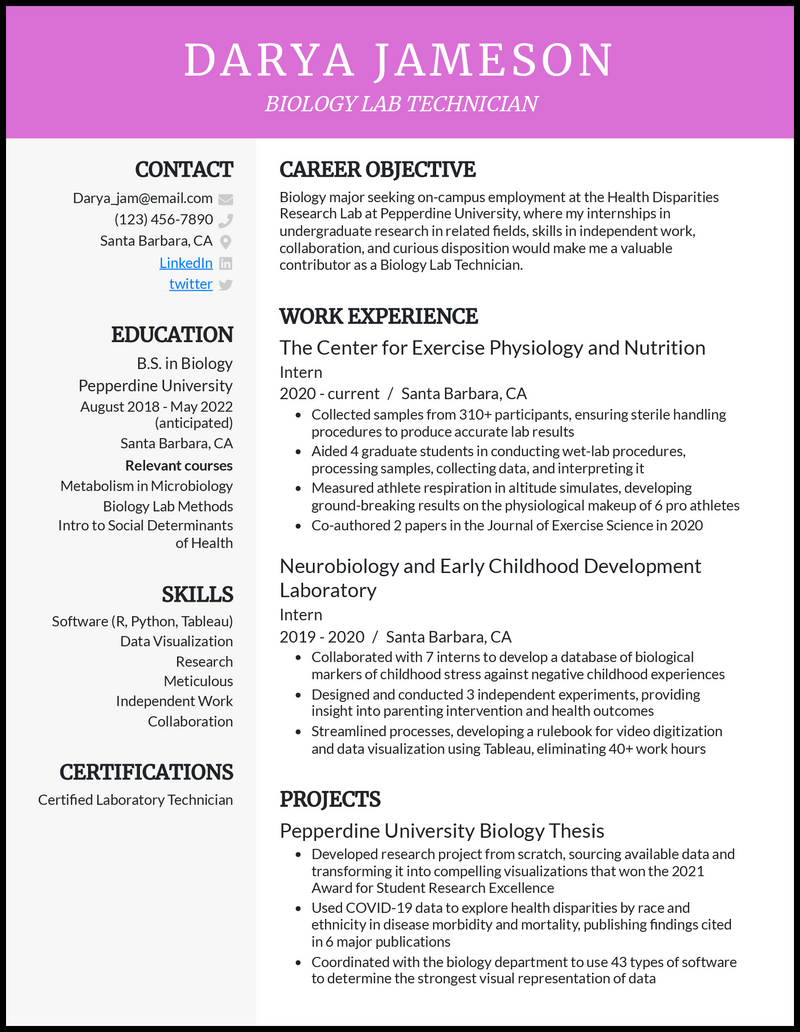

With your job experience and a stunning resume layout, recruiters will be ready to give your application the official stamp of approval.
Like this template? Customize this resume and make it your own with the help of our Al-powered suggestions, accent colors, and modern fonts.
Companies sometimes require that entry-level candidates have experience, but how do you get experience when even entry-level jobs make it difficult to apply?
Getting that first job or internship can be the most challenging part of your career. Fortunately, as a college student, you’re in a great position to get that first break you need. Once you get your degree, you’ll have the experience employers are seeking, but until then, how can you build an effective resume or write a cover letter as a college student?
After reviewing countless resume samples, we’ve determined what types employers want to see from college students. Furthermore, we used that knowledge to create 22 college student resume examples to help inspire your resume in 2024.























Before we dive into the difference between a resume objective vs. a resume summary, let’s get some definitions out of the way:
When you’re applying for a job or internship as a college student, you likely won’t have extensive work experience. So, we’d recommend including a resume objective instead of a resume summary.
The goal of your resume objective is to set the stage for your resume. It should highlight your skills applicable to the job at hand, and it should be specific for each job to which you’re applying.
Most resume objectives are boring and generic. By taking the time to craft a customized and effective resume objective, you give yourself an edge over other applicants and increase your chances of getting an interview.
Before we dive into the rules for creating a strong resume objective, let’s look at some examples.
You can see that all of these resume objectives specifically mention the company that the student is applying to. Tailoring is the golden rule of resume objectives.
Here are some other rules to make your objective the best it can be:

One of the hardest parts of using a resume maker as a college student is the blank page. The “getting started” part is overwhelming—you’re unsure what your resume should look like, let alone what should be in it!
When it comes to formatting your resume, the best advice is to keep it simple. You need to convincingly make the case that you deserve an interview for the role to which you’re applying.
In short, your resume should likely contain the following sections:
Not all of these sections need to be included in your resume. Your resume should focus on your strengths.
If you don’t have much relevant work experience, you can omit that section in favor of discussing your projects or classwork.
However, no matter what format you choose, there are a few writing guidelines you should adhere to throughout your resume.
When building your skills section, it can be tempting to list any and every skill you know. You’ll have to resist this temptation.
Before a human reviews your resume, an automated system called an Applicant Tracking System (ATS) will score your resume based on whether or not it includes the “right” keywords. These filters are largely screening for specific skills.
Doesn’t this mean that you should include as many skills as possible to beat the ATS? Unfortunately, you need to make your resume appealing to both the ATS and a human, and nothing is a bigger red flag to a hiring manager than a candidate with a laundry list of skills!
You’re much better off focusing on six to ten skills you’re an expert in than including more that you kind of know. Generally, if you wouldn’t be comfortable being interviewed on a given skill, don’t include it on your resume.

In any resume, no matter the career stage, your work experience and projects should take up at least 70 percent of the overall space. These will decide whether you get an interview or not.
Once you have a few years of experience, then the size of your projects section will decrease as the size of your work experience section expands.
If you have an internship relevant to the job you’re applying for, this should be listed in your “work experience” section. As a college student, your work experience can also contain any part-time jobs you had while in school, even if they don’t seem relevant to the position to which you’re applying.
It’s not easy to balance work and school, so having a part-time job demonstrates responsibility and drive.
When talking about your work experience, there are a few key tips you should follow:
Numbers truly speak louder than words, especially on your resume. By providing numerical context around your work, you show your ability to contribute meaningfully to your workplace.
Compare these two descriptions of an internship. Which do you think would be more compelling to a hiring manager?
Marketing Science Associates
April 2020 – Current, New York NY
Digital Marketing Intern
Marketing Science Associates
April 2020 – Current, New York NY
Digital Marketing Intern
If you don’t have much (or any) relevant work experience for your resume, don’t fret. You can still create a highly effective resume by showcasing your projects.
As a college student, you’ve likely done a lot of class projects that are relevant to the job or internship you’re looking to get. This is the perfect place to talk about those projects. You can even mention projects you completed outside of class. Talk about your goals, the methods/skills you used, and the project’s outcome.
The key is to include anything that will convince the hiring manager you have the drive, skills, and ability to translate your academic knowledge to the real world and contribute to the roles for which you’re applying.
Here are some potential projects you can work on for different majors:
Basically, the projects you include on your resume can be just about anything. They simply have to demonstrate you know what is required of the kind of role you’re applying to, and that you can meet those requirements.

As a college student, it should go without saying that you need to include an education section on your resume.
Here’s what you need to include in your education section no matter what:
Once you include all that, there’s more flexibility. If you have a strong GPA (greater than 3.5), you should include it, too.
If you don’t have much experience yet, then you can add relevant courses or awards to your education section, provided they’re relevant to the job for which you’re applying.
For example, if you’re applying for a role as a data scientist, then it makes sense to include any math, economics, or programming classes you completed.
Here’s an example of an effective education section for a college student looking for a marketing role:

If you received any awards or honors during your time in college, list them here. These can include getting on the Dean’s List, any department-specific awards relevant to your major, or formal recognition for your work or volunteer efforts.

There you have it—we’ve discussed the building blocks to help you land a job or internship as a college student!
In summary, here are the keys to making an effective resume as a college student:
Finding a job or internship as a college student can be incredibly stressful. Building anAI resume is a huge first step, so pat yourself on the back. After you’re done with the writing, you can check your resume against our AI-powered tips to see how your resume matches up.
Just remember, it does get easier after you get some experience first. We can’t wait to see where you’ll go!